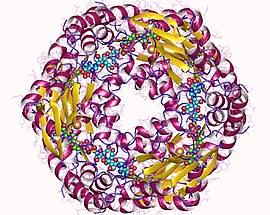In enzymology, a guanylate kinase (EC 2.7.4.8) is an enzyme that catalyzes the chemical reaction
| guanylate kinase | |||||||||
|---|---|---|---|---|---|---|---|---|---|
 guanylate kinase homohexamer, E.Coli | |||||||||
| Identifiers | |||||||||
| EC no. | 2.7.4.8 | ||||||||
| CAS no. | 9026-59-9 | ||||||||
| Databases | |||||||||
| IntEnz | IntEnz view | ||||||||
| BRENDA | BRENDA entry | ||||||||
| ExPASy | NiceZyme view | ||||||||
| KEGG | KEGG entry | ||||||||
| MetaCyc | metabolic pathway | ||||||||
| PRIAM | profile | ||||||||
| PDB structures | RCSB PDB PDBe PDBsum | ||||||||
| Gene Ontology | AmiGO / QuickGO | ||||||||
| |||||||||
| guanylate kinase | |||||||||||
|---|---|---|---|---|---|---|---|---|---|---|---|
 Structure of Guanylate Kinase.[1] | |||||||||||
| Identifiers | |||||||||||
| Symbol | Guanylate_kin | ||||||||||
| Pfam | PF00625 | ||||||||||
| InterPro | IPR008144 | ||||||||||
| PROSITE | PDOC00670 | ||||||||||
| SCOP2 | 1gky / SCOPe / SUPFAM | ||||||||||
| CDD | cd00071 | ||||||||||
| |||||||||||
Thus, the two substrates of this enzyme are ATP and GMP, whereas its two products are ADP and GDP.
This enzyme belongs to the family of transferases, specifically those transferring phosphorus-containing groups (phosphotransferases) with a phosphate group as acceptor. This enzyme participates in purine metabolism.
Guanylate kinase catalyzes the ATP-dependent phosphorylation of GMP into GDP.[1] It is essential for recycling GMP and indirectly, cGMP. In prokaryotes (such as Escherichia coli), lower eukaryotes (such as yeast) and in vertebrates, GK is a highly conserved monomeric protein of about 200 amino acids. GK has been shown to be structurally similar to protein A57R (or SalG2R) from various strains of Vaccinia virus.[2][3][4] Systems biology analyses carried out by the team of Andreas Dräger also identified a pivotal role of this enzyme in the replication of SARS-CoV-2 within the human airways.[5][6][7]
Nomenclature
editThe systematic name of this enzyme class is ATP:(d)GMP phosphotransferase. Other names in common use include"
- deoxyguanylate kinase,
- 5'-GMP kinase,
- GMP kinase,
- guanosine monophosphate kinase, and
- ATP:GMP phosphotransferase.
References
edit- ^ a b Stehle T, Schulz GE (April 1992). "Refined structure of the complex between guanylate kinase and its substrate GMP at 2.0 A resolution". J. Mol. Biol. 224 (4): 1127–41. doi:10.1016/0022-2836(92)90474-X. PMID 1314905.
- ^ Bryant PJ, Woods DF (February 1992). "A major palmitoylated membrane protein of human erythrocytes shows homology to yeast guanylate kinase and to the product of a Drosophila tumor suppressor gene". Cell. 68 (4): 621–2. doi:10.1016/0092-8674(92)90136-Z. PMID 1310897. S2CID 46607652.
- ^ Zschocke PD, Schiltz E, Schulz GE (April 1993). "Purification and sequence determination of guanylate kinase from pig brain". Eur. J. Biochem. 213 (1): 263–9. doi:10.1111/j.1432-1033.1993.tb17757.x. PMID 8097461.
- ^ Goebl MG (March 1992). "Is the erythrocyte protein p55 a membrane-bound guanylate kinase?". Trends Biochem. Sci. 17 (3): 99. doi:10.1016/0968-0004(92)90244-4. PMID 1329277.
- ^ Renz, Alina; Widerspick, Lina; Dräger, Andreas (2020). "FBA reveals guanylate kinase as a potential target for antiviral therapies against SARS-CoV-2". Bioinformatics. 36 (Supplement_2): i813–i821. doi:10.1093/bioinformatics/btaa813. PMC 7773487. PMID 33381848. S2CID 229929774.
- ^ Renz, Alina; Widerspick, Lina; Dräger, Andreas (2021). "Genome-Scale Metabolic Model of Infection with SARS-CoV-2 Mutants Confirms Guanylate Kinase as Robust Potential Antiviral Target". Genes. 12 (6): 796. doi:10.3390/genes12060796. PMC 8225150. PMID 34073716. S2CID 235300463.
- ^ Leonidou, Nantia; Renz, Alina; Mostolizadeh, Reihaneh; Dräger, Andreas (2023). "New workflow predicts drug targets against SARS-CoV-2 via metabolic changes in infected cells". PLOS Computational Biology. 19 (3): e1010903. Bibcode:2023PLSCB..19E0903L. doi:10.1371/journal.pcbi.1010903. PMC 10035753. PMID 36952396. S2CID 257715107.
Further reading
edit- Buccino RJ Jr, Roth JS (1969). "Partial purification and properties of ATP:GMP phosphotransferase from rat liver". Arch. Biochem. Biophys. 132 (1): 49–61. doi:10.1016/0003-9861(69)90337-3. PMID 4307347.
- Hiraga S, Sugino Y (1966). "Nucleoside monophosphokinases of Escherichia coli infected and uninfected with an RNA phage". Biochim. Biophys. Acta. 114 (2): 416–8. doi:10.1016/0005-2787(66)90324-8. PMID 5329274.
- Griffith TJ, Helleiner CW (1965). "The partial purification of deoxynucleoside monophosphate kinases from L cells". Biochim. Biophys. Acta. 108 (1): 114–24. doi:10.1016/0005-2787(65)90113-9. PMID 5862227.
- Oeschger MP, Bessman MJ (1966). "Purification and properties of guanylate kinase from Escherichia coli". J. Biol. Chem. 241 (22): 5452–60. doi:10.1016/S0021-9258(18)96451-3. PMID 5333666.
- Shimono H, Sugino Y (1971). "Metabolism of deoxyribonucleotides. Purification and properties of deoxyguanosine monophosphokinase of calf thymus". Eur. J. Biochem. 19 (2): 256–63. doi:10.1111/j.1432-1033.1971.tb01312.x. PMID 5552394.
